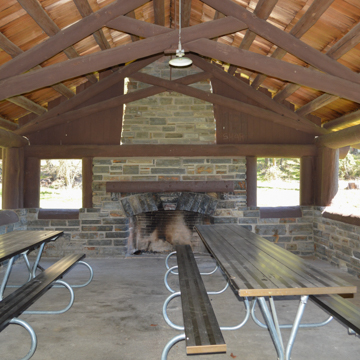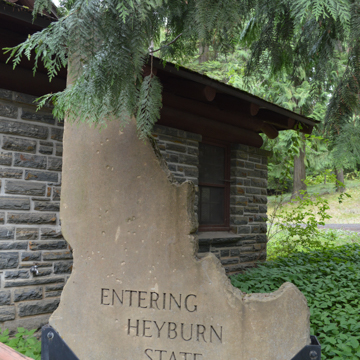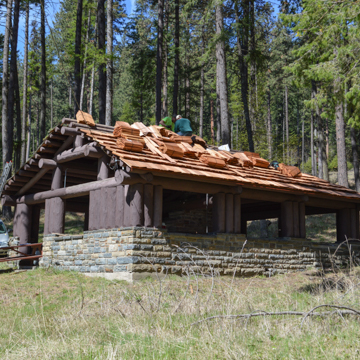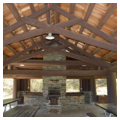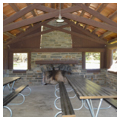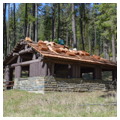You are here
Heyburn State Park
As the first state park in the Pacific Northwest, Heyburn Park was founded in 1908. Although initial steps had been taken to set aside the land for natural systems conservation and public enjoyment, the state of Idaho lacked adequate resources to develop recreational facilities in the park until the arrival of President Roosevelt’s Depression-era Civilian Conservation Corps (CCC). Between 1933 and 1938, the harnessed energy of 115 young men from CCC Camp SP-1 1995 transformed Heyburn Park’s largely undeveloped natural environment into a destination for public enjoyment and outdoor recreation. Under the direction of the National Park Service (NPS), CCC work crews crafted a harmonious and picturesque built environment in the park, one that still prevails today.
The “Schitsu’umsh,” a tribal people French fur traders named the Coeur d’Alene, were the first known inhabitants of the land that would become Heyburn State Park. Among the four million acres that once constituted the Coeur d’Alene’s tribal territory, Heyburn Park’s three lakeshores and old-growth forests were vital for fishing, hunting, and gathering. The natural environment remained protected as part of the Coeur d’Alene reservation until tribal holdings were intentionally diminished through the General Allotment Act of 1887 and Homestead Act of 1906, which sought to transfer land ownership to private individuals. Fearing privatization of lakeshores and associated watersheds, Idaho Senator Weldon Heyburn championed permanent conservation through pursuit of a national park designation. Although Senator Heyburn was unsuccessful, Congress established a pathway for the state of Idaho to assume ownership of 8,076 acres of tribal lands and waters for the purpose of establishing a state park focused on outdoor recreation and natural resource management. Heyburn’s intent was for the park to bring national recognition and revenue to Idaho. In reality the park served a regional market of visitors from Spokane, Coeur d’Alene, St. Maries, and other Washington and North Idaho communities that could access the park by railroad or ferry service.
During the Great Depression, Idaho was second only to California in support received from the ten-year CCC program and Heyburn Park was the only state park in Idaho to benefit from the program. Given that Idaho’s historically sparse population encompassed a large geographic area, resource capacity to develop and manage state parks was, and remains, challenging. Prior to the CCC intervention, Heyburn Park lacked most visitor amenities, including basic infrastructure and housing for park managers. Work completed by CCC Camp SP-1 1995 was transformative; crews built roads, bridges and water infrastructure, and they rendered Heyburn Park’s stunning lakeshores and variegated forests and marshlands accessible for hiking, camping, picnicking, fishing, boating, and bird watching by adding campground facilities, lodging, restrooms, bathhouses, hiking trails, and picnic shelters.
Heyburn Park’s picturesque image can be attributed to the NPS’s role in guiding master planning, design, and construction decisions. In Idaho a majority of CCC projects were completed under the direction of the United States Forest Service (USFS), which subscribed to use of standardized plans, milled lumber, and mechanized construction methods. By contrast, the design of CCC structures at Heyburn Park was guided by the NPS’s design aesthetic which championed the rustic style and resisted the use of standardized materials and construction techniques; in the case of Heyburn Park, NPS specifications were highly detailed in their directives for park buildings to harmonize with nature. San Francisco-based NPS landscape architect Erving Trimble guided implementation of the park’s master plan and site development to insure integration between structures and their natural settings. Architectural standards called for buildings to be hand crafted from native materials. Staff architects from the NPS’s regional offices in San Francisco and Portland provided design inspiration and guidance. The park manager’s house at Plummer Point, in particular, exhibits design characteristics consistent with the works architect William Fox of NPS Division 1.
Camp SP-1 Company 1995 worked under the direct supervision of park service employee Rex Wendle, who also served as Heyburn Park’s first superintendent. Wendle engaged a team of eight local experienced men to lead and train Camp SP-1 1995 work crews. CCC crews were organized according to trade specialties and trained in park service techniques; forestry crews used crosscut handsaws to harvest tamarack and Douglas fir logs within park boundaries. Foresters in training were encouraged to select timbers for their uniqueness, rather than uniformity; CCC quarry crews were instructed to provide a supply of local Benewah shale that varied in size and texture. Crews in charge of construction were taught how to celebrate craft and handiwork: structural logs were peeled and hand selected for their knots and non-conformities; log smiths hand cut joints for laying up walls and connecting structural logs; and siding, whether wood boards or half log veneer, was arranged vertically in some cases to mimic tree growth. NPS standards called for masonry crews to select stones with varying properties and to emulate natural stone beds by setting them horizontally, “never vertically.” CCC crews were also taught how to hand fabricate accessories such as door hardware and light fixtures. The cumulative effect was an aesthetic defined by the natural properties of materials and non-mechanized methods for their assembly. CCC participants honed new trades and skills through processes of hand-making and assembling construction materials.
NPS oversight insured that throughout Heyburn Park’s recreation areas, including Rocky Point, Plummer Point, and Chatcolet, CCC buildings were uniformly rustic and shared a common architectural language whether they were guest lodges, residences for park administrators, picnic shelters, or restrooms. First and foremost, buildings were designed to harmonize with nature in order to better connect users to the park’s natural environment. Each structure was intended to be site specific. Slight variations in scale, orientation, and massing of individual structures reflect subtle differences in their immediate landscapes. Use of native materials, rendered in natural finishes enables park buildings to blend in with their surroundings. A majority of structures feature low profile rooflines and informal massing. Stone masonry is artfully combined with hand-hewn timbers to achieve a subtly rustic architectural statement.
The Lodge at Rocky Point, which operated as a concessionaire with restaurant and six lodging rooms, is the most ambitious CCC structure in the park. Though small in scale, the building’s design is reminiscent of lodge architecture throughout the western United States. Individual guest rooms have recessed dormers framed with exposed log rafters and purlins. Consistent with rustic materiality, the lodge is anchored by a concrete base faced with a veneer of local basalt. Solid log walls above support hand-hewn exposed rafters and purlins. The first floor hosted a restaurant with stone fireplace, kitchen, and adjoining social spaces, which are no longer operational.
Among the picnic shelters distributed throughout the park, the Chatcolet area features two of the most impressive. Entry to each gable-end structure is celebrated by log cross gables. Stone masonry cook stoves anchor building cores beneath exposed hand-scribed log trusses. Roofs were finished with hand-cut cedar shakes from native trees. Windowless openings feature half log sills set on top of random coursed ashlar stonework.
The fruits of CCC Camp SP-1 1995’s labors left an ecologically sensitive and enduring mark on Heyburn Park’s exquisite natural environment. Among Idaho’s state parks and forest service facilities, Heyburn Park’s picturesque aesthetic is unsurpassed. Ongoing stewardship of CCC-era facilities insures that the park’s natural beauty and wildlife can be enjoyed by current and future generations without the negative impact of intrusive development. Today, the Idaho Department of Parks and Recreation and Heyburn Park management embrace the CCC’s profound contributions by promoting both active use and on-going preservation of inherited architectural resources.
References
Austin, Judith. “The CCC in Idaho.” Idaho Yesterdays(Fall 1983). Accessed May 16, 2015. http://idahoptv.org/outdoors/shows/ccc/idaho/austinarticle.html.
Idaho State Parks and Recreation Board. “Heyburn State Park Master Plan, 2010.” Idaho Department of State Parks and Recreation. Accessed May 17, 2015. http://parksandrecreation.idaho.gov/sites/default/files/uploads/documents/Heyburn/2010%20Heyburn%20Master%20Plan%20Final.pdf.
Idaho State Parks and Recreation Board. Heyburn State Park General Development Plan. Boise: Idaho Department of State Parks and Recreation, 1990.
McCroskey, Lauren, “Chatcolet CCC Picnic and Camping Area,” Plummer County, Idaho. National Register of Historic Places Registration Form, 1994. National Park Service, U.S. Department of the Interior, Washington DC.
McCroskey, Lauren, “Plummer Point Picnic and Hiking Area,” Plummer County, Idaho. National Register of Historic Places Registration Form, 1994. National Park Service, U.S. Department of the Interior, Washington DC.
McCroskey, Lauren, “Rocky Point CCC Properties,” Plummer County, Idaho. National Register of Historic Places Registration Form, 1995. National Park Service, U.S. Department of the Interior, Washington DC.
McKinley, Mike. “The Civilian Conservation Corps and Heyburn Park Experience 1934–1942. Excerpt from With reminiscences from the men who were there. Idaho Public Television. Accessed May 16, 2015. http://idahoptv.org/outdoors/shows/ccc/idaho/cccheyburn.html.
Nelson, Ivar, D. Becker, and P. Hart. “CCC in Idaho Collection-Digital Initiative Preview.” University of Idaho Library. Accessed April 27, 2015. http://www.lib.uidaho.edu/digital/cccidaho/.
Writing Credits
If SAH Archipedia has been useful to you, please consider supporting it.
SAH Archipedia tells the story of the United States through its buildings, landscapes, and cities. This freely available resource empowers the public with authoritative knowledge that deepens their understanding and appreciation of the built environment. But the Society of Architectural Historians, which created SAH Archipedia with University of Virginia Press, needs your support to maintain the high-caliber research, writing, photography, cartography, editing, design, and programming that make SAH Archipedia a trusted online resource available to all who value the history of place, heritage tourism, and learning.















